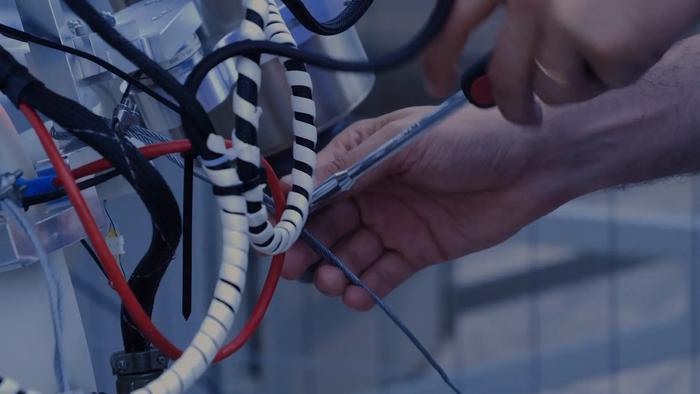In a remarkable leap for humanoid robotics, researchers at the Italian Institute of Technology (IIT) have successfully completed the first flight demonstration of iRonCub3, a pioneering jet-powered humanoid robot engineered for real-world applications. This revolutionary development marks a significant step forward in the intersection of robotics and aeronautics, potentially transforming the future of flying robots. The iRonCub3 can lift off to an altitude of about 50 centimeters while ensuring stability, an impressive feat that showcases the incredible engineering and technological innovations ingrained in its design.
Conducted over two years, the research and engineering efforts behind iRonCub3 exemplify the challenges faced in developing flying humanoid robots. The complexities of aerodynamics, coupled with the intricacies involved in robotic control, demanded a comprehensive study of the robot’s dynamic balance and movement. Unlike traditional drones that boast symmetrical forms, iRonCub3 flaunts a distinctly humanoid shape, bringing with it unique challenges related to center of mass and limb motion. The need for sophisticated control systems that can accommodate these complexities ultimately forged new paths in robotic research.
As reported in a recently published paper in Nature Communications Engineering, the research collaboration involved experts from various disciplines. The IIT team teamed up with the DAER Aerodynamics Laboratory at the Polytechnic of Milan, where rigorous wind tunnel tests were conducted, and with Stanford University, where deep learning techniques were employed to enhance the understanding of aerodynamic forces. This collaborative approach was pivotal in addressing the challenges posed by iRonCub3’s nuanced design and functionality.
Significant technological advancements were made possible thanks to the integration of thermodynamics and advanced control systems, laying the groundwork for the successful flight of iRonCub3. The design incorporates four jet engines to afford the robot aerial mobility, positioned strategically on its arms and back. The development of a titanium spine and heat-resistant covers illustrates the attention to detail required to protect the robot from the extreme temperatures experienced during operation, thus ensuring both safety and performance efficiency.
The research team, led by Daniele Pucci, emphasized the need for real-time evaluation of the aerodynamic conditions affecting the iRonCub3 during flight. By harnessing innovative AI methodologies, they addressed the dual challenge of controlling both the robot’s slow-moving joints and the rapid responses of the jet propulsion system. This level of complexity means the robot’s testing environment requires precision and caution, underscoring the risks associated with flying humanoids— an area still in its infancy compared to other robotics fields.
One of the most striking achievements of the iRonCub3 project is the codevelopment of dynamic balance models specific to its unique construction. The research indicated that to achieve controlled flight, the team had to devise models that managed the continual shifts in mass distribution caused by the robot’s movements. Through iterative testing and refinements, these dynamic balance models have enabled iRonCub3 to handle challenges that traditional drones would struggle to manage.
The consequences of these developments extend beyond technical prowess; they open up possibilities for iRonCub3 to serve critical roles in various scenarios. The humanoid design coupled with its aerial capabilities makes it an ideal candidate for search-and-rescue missions, hazardous inspections, and other difficult environments where traditional robots might falter. Its ability to maneuver through challenging terrains while maintaining human-like mobility can provide an invaluable asset in times of crisis or exploration.
The successful flight testing at IIT’s dedicated flight-testing area showcased the robot’s seamless lift-off and stability, but it’s only the beginning. Plans are underway for more comprehensive testing scenarios in collaboration with Genoa Airport to ensure that future experiments push the boundaries of what flying humanoid robots can achieve. As the development shifts to larger testing environments, iRonCub3’s capabilities may soon be seen beyond the confines of research facilities.
Central to the concept of iRonCub3 is its underlying AI control architecture. This system utilizes neural networks trained on both simulated environments and real-world tests, allowing for the rapid prediction of aerodynamic forces acting on the robot during flight. The result is a highly adaptable system capable of processing environmental variables and maintaining stable flight, even in turbulent conditions that would challenge less complex systems.
The aviation frontier of robotics continues to evolve, with iRonCub3 standing as a testament to the ongoing efforts to create machines that not only mimic human appearance but can also replicate human capabilities in complex environments. The revolutionary design principles guiding iRonCub3, including co-design processes that align AI functionalities with aerodynamics and thermodynamics, signify a turning point in robot development strategies. This iconic robot represents a new narrative in the robotics sector, merging the realms of flight and humanoid functionality.
As iRonCub3 gains further testing and refinement, its impact on future robotic design and application remains to be seen. It could redefine the capabilities of robots in various fields, bridging the gap between land and air mobility and showcasing the potential of advanced robotics. With the integration of novel approaches and cross-disciplinary collaboration, the aspirations surrounding humanoid robots like iRonCub3 are becoming increasingly achievable, heralding an exciting era for robotics and technology as a whole.
The future holds immense promise for flying humanoid robots, particularly for applications that necessitate both aerial and terrestrial function. With evolving technologies and methods, research teams can explore dimensions of robotics has barely scratched the surface. The road ahead is paved with ambitious goals of developing additional capabilities and operational environments, holding the potential to revolutionize industries that rely on human-like robots.
As humanity continues to innovate and explore the capabilities of robotics, iRonCub3 will undoubtedly serve as a front-runner in the ongoing journey toward integrating humanoid robotics into everyday life. This remarkable robot will inspire future generations of engineers and researchers to push the limits of what robotics can accomplish, paving the way for technologies that once belonged merely to the realm of science fiction.
Subject of Research:
Article Title: Learning Aerodynamics for the Control of Flying Humanoid Robots
News Publication Date: 18-Jun-2025
Web References: Link to Nature Communications Engineering
References:
Image Credits: Credit: IIT-Istituto Italiano di Tecnologia




